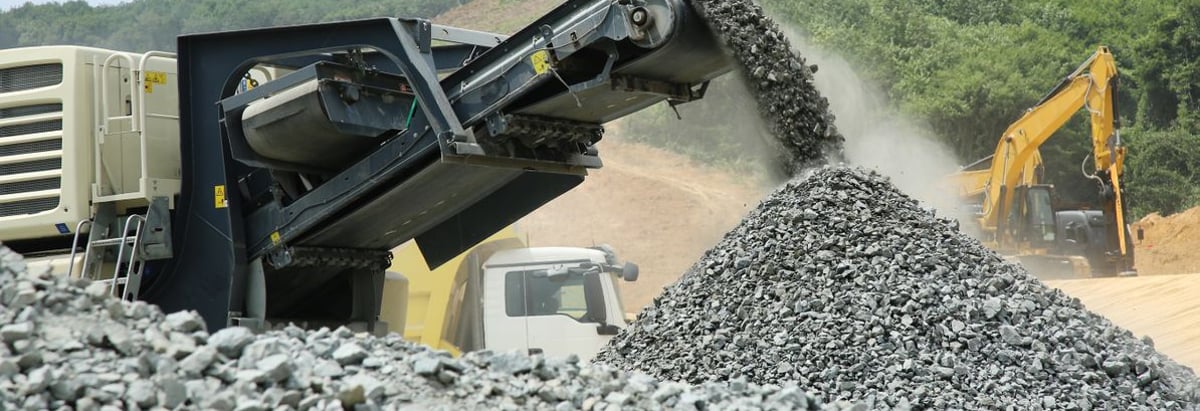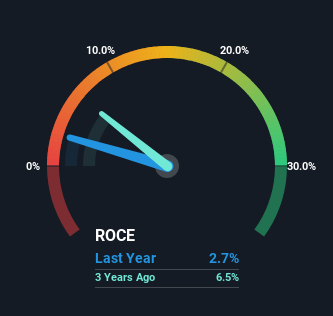- Japan
- /
- Basic Materials
- /
- TSE:5232
Sumitomo Osaka Cement (TSE:5232) Could Be Struggling To Allocate Capital

If we're looking to avoid a business that is in decline, what are the trends that can warn us ahead of time? When we see a declining return on capital employed (ROCE) in conjunction with a declining base of capital employed, that's often how a mature business shows signs of aging. Ultimately this means that the company is earning less per dollar invested and on top of that, it's shrinking its base of capital employed. In light of that, from a first glance at Sumitomo Osaka Cement (TSE:5232), we've spotted some signs that it could be struggling, so let's investigate.
What Is Return On Capital Employed (ROCE)?
For those who don't know, ROCE is a measure of a company's yearly pre-tax profit (its return), relative to the capital employed in the business. The formula for this calculation on Sumitomo Osaka Cement is:
Return on Capital Employed = Earnings Before Interest and Tax (EBIT) ÷ (Total Assets - Current Liabilities)
0.027 = JP¥7.3b ÷ (JP¥356b - JP¥89b) (Based on the trailing twelve months to March 2024).
Therefore, Sumitomo Osaka Cement has an ROCE of 2.7%. Ultimately, that's a low return and it under-performs the Basic Materials industry average of 8.2%.
See our latest analysis for Sumitomo Osaka Cement

Above you can see how the current ROCE for Sumitomo Osaka Cement compares to its prior returns on capital, but there's only so much you can tell from the past. If you'd like to see what analysts are forecasting going forward, you should check out our free analyst report for Sumitomo Osaka Cement .
What Can We Tell From Sumitomo Osaka Cement's ROCE Trend?
In terms of Sumitomo Osaka Cement's historical ROCE movements, the trend doesn't inspire confidence. To be more specific, the ROCE was 5.8% five years ago, but since then it has dropped noticeably. On top of that, it's worth noting that the amount of capital employed within the business has remained relatively steady. Since returns are falling and the business has the same amount of assets employed, this can suggest it's a mature business that hasn't had much growth in the last five years. If these trends continue, we wouldn't expect Sumitomo Osaka Cement to turn into a multi-bagger.
Our Take On Sumitomo Osaka Cement's ROCE
All in all, the lower returns from the same amount of capital employed aren't exactly signs of a compounding machine. And, the stock has remained flat over the last five years, so investors don't seem too impressed either. Unless there is a shift to a more positive trajectory in these metrics, we would look elsewhere.
Sumitomo Osaka Cement does have some risks though, and we've spotted 2 warning signs for Sumitomo Osaka Cement that you might be interested in.
If you want to search for solid companies with great earnings, check out this free list of companies with good balance sheets and impressive returns on equity.
New: Manage All Your Stock Portfolios in One Place
We've created the ultimate portfolio companion for stock investors, and it's free.
• Connect an unlimited number of Portfolios and see your total in one currency
• Be alerted to new Warning Signs or Risks via email or mobile
• Track the Fair Value of your stocks
Have feedback on this article? Concerned about the content? Get in touch with us directly. Alternatively, email editorial-team (at) simplywallst.com.
This article by Simply Wall St is general in nature. We provide commentary based on historical data and analyst forecasts only using an unbiased methodology and our articles are not intended to be financial advice. It does not constitute a recommendation to buy or sell any stock, and does not take account of your objectives, or your financial situation. We aim to bring you long-term focused analysis driven by fundamental data. Note that our analysis may not factor in the latest price-sensitive company announcements or qualitative material. Simply Wall St has no position in any stocks mentioned.
Have feedback on this article? Concerned about the content? Get in touch with us directly. Alternatively, email editorial-team@simplywallst.com
About TSE:5232
Sumitomo Osaka Cement
Engages in the cement production business in Japan and internationally.
Excellent balance sheet average dividend payer.
Similar Companies
Market Insights
Community Narratives



